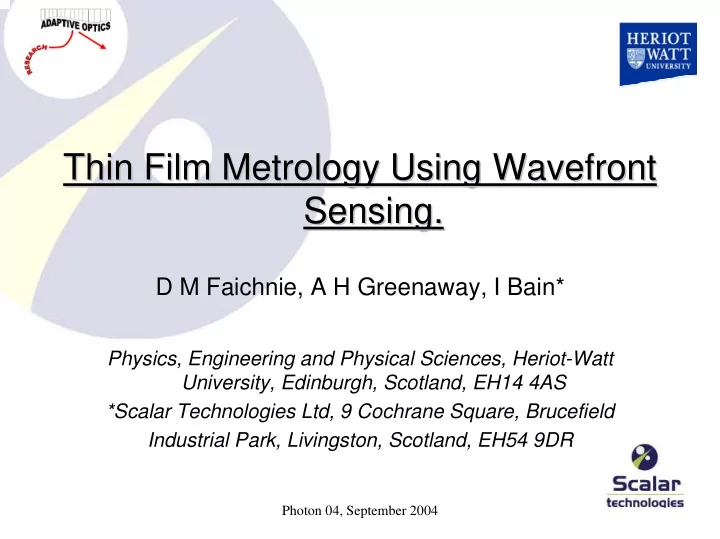

Thin Film Metrology Using Wavefront Thin Film Metrology Using Wavefront Sensing. Sensing. D M Faichnie, A H Greenaway, I Bain* Physics, Engineering and Physical Sciences, Heriot-Watt University, Edinburgh, Scotland, EH14 4AS *Scalar Technologies Ltd, 9 Cochrane Square, Brucefield Industrial Park, Livingston, Scotland, EH54 9DR Photon 04, September 2004
Acknowledgements. Acknowledgements. OMAM Collaborators. Funding Institutions. Photon 04, September 2004
Overview Of Presentation. Overview Of Presentation. • What is Adaptive Optics and how can we use it for metrology. • Project aims. • Analysis of measurement and experimental set-up. • Results To Date and System Calibration. • Future Work and sensor design. • Conclusions. Photon 04, September 2004
Typical AO Vs Metrology. Typical AO Vs Metrology. AO System. Metrology Using AO Wavefront Sensor and Science Camera m o r F t t h c g e i j L b O Sample Under Test Feedback Control System Photon 04, September 2004
Project Aims. Project Aims. • Produce robust industrial thickness monitor. • Sensor must be able to be used in-line for control feedback. • Sensor should be able to measure coloured films. • Sensor should be able to cope with rough sample surfaces. • Sensor should be able to be used with multiple layer laminates. • Accuracy dependent on application, could be as low as 10nm. Photon 04, September 2004
Analysis Of Current Measurement. Analysis Of Current Measurement. Detector Point Source Plane Input Lens Lens Air, n 0 Film, n 1 Virtual Source 1 Substrate, n 2 Virtual Source 2 Photon 04, September 2004
Experimental Set- -Up. Up. Experimental Set Point Source Lens 1 Input Sample Single Mode Fibre Translation Stage Lens 2 Variable Aperture Microscope Objective Variable ND Filter HeNe Laser CCD Array Photon 04, September 2004
Results To Date. Results To Date. Photon 04, September 2004
System Calibration. System Calibration. • Our optical system requires calibration before we can relate pixel separation to actual thickness. • Separation will change with angle of illumination, magnification of optical system, thickness, refractive index and surface tilt. • Number of options : • Absolute calibration with prism + model of refraction. • Relative calibration with calibrated sample set. • Calibration with system model. • Choice will be dependent on application. Photon 04, September 2004
Example Of Relative Calibration. Example Of Relative Calibration. • Results from four samples ranging from 250 to 500 microns. • Lets make 500 micron sample our calibration sample. Actual thickness 480 microns, use pixel separation to get calibration value to gain measure of pixels/micron for system. Nominal Measured Sample Thickness (µm) Thickness (µm) 450 Micron 426 +/- 5 µm 423.6 +/- 7.7 µm 350 Micron 378 +/- 4.47 µm 377.3 +/- 6.3 µm 250 Micron 234 +/- 5.47 µm 235.8 +/- 5.48 µm Photon 04, September 2004
Theory Of Future Measurement. Theory Of Future Measurement. • Phase Diversity Wavefront sensor used to measure aberrations introduced by the film structure. • Addition of diffractive optical element to current set-up. • Use of generalised phase diversity to optimise DOE design for thickness measurement. • Design sensor to be most sensitive to aberrations expected. • Tilt, Defocus, Astigmatism, Coma, Spherical, Trefoil Photon 04, September 2004
Future Sensor Design. Future Sensor Design. S a m p l e Point Source Pigtailed Laser Input Diode DOE Control Signal Output On Board Programmable Electronics CCD • Small compact sensor design • Can be mounted on industrial scanner Photon 04, September 2004
Future Work. Future Work. • Model wavefront sensor system using plane wave decomposition. • Use model results to design appropriate DOE for sensor. • Incorporate DOE into current system and test. • Investigate application to curved and textured surfaces. • Investigate simultaneous measurement of thickness and refractive index. Photon 04, September 2004
Conclusions. Conclusions. • Current measurement can be used for films 8mm to 12 microns. • Technique should be able to work down to below 3 microns. • Experimentally shown linear relationship between virtual source position and thickness. • Shown that relative calibration approach can be accurate. • Shown that sensor should be compact and will be able to be used in-line in industrial processes. Photon 04, September 2004
Recommend
More recommend